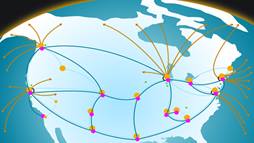ESnet Enhances Scientific Productivity Around the Globe
 Photo courtesy of Lawrence Berkeley National Laboratory
Photo courtesy of Lawrence Berkeley National Laboratory
ESnet enables scientists at distant locations to coordinate research and analysis in real-time collaboration.
You're happy with your new blazing fast, upgraded home Internet speed – top speed maybe 10 megabits a second. But what if you could have Internet access 10,000 times faster? How awesome would that be?
ESnet – the Energy Sciences Network – is an organization focused on moving data at lightening speed so that geographical barriers don't limit researchers. It's a specialized network with high-speed, high-capability connections that links scientists to research facilities, world-class scientific equipment, and some of the fastest computers in the world.
ESnet's speed and capabilities are creating opportunities for real-time collaborations between scientists and equipment in far-flung locations. For instance, researchers at Lawrence Berkeley National Laboratory's Advanced Light Source (ALS) used ESnet to manage real-time data transfers with National Energy Research Scientific Computing Center (NERSC) in California and Oak Ridge Leadership Computing Facility (OLCF) in Tennessee to test a new method of fabricating organic photovoltaics.
Organic photovoltaics (OPVs) have greater flexibility than traditional solar cells, promising increased energy efficiency and reduced costs. However, they are challenging to produce in large quantities.
Using an ALS scattering beamline, the research team gathered data as the OPV samples were made. The data were transferred via ESnet to NERSC for initial processing, then on to OLCF for full analysis on the supercomputer, Titan. Throughout the experiment, the connected data, machines and staff worked as one group: a superfacility.
"A superfacility is two or more facilities interconnected by means of a high performance science network," explained Eli Dart, an ESnet network engineer. "Multiple facilities are linked together over a fast network using workflow and data management software such that the scientific output of the connected facilities is greater than it otherwise could be."
"The typical way researchers have used NERSC and Titan in the past is they are perceived as independent facilities used for particular purposes, and coordinating one with the other is kind of a manual thing in terms of scheduling time, etc.," said Craig Tull, who heads Berkeley Lab's Physics and X-Ray Science Computing Group and coined the term "superfacility" to describe the linking of multiple facilities. "What we did here that was really unique; we were co-scheduling beamline time at the ALS and time and resources at NERSC and Oak Ridge, plus ESnet to string it all together. This was the first time we'd done anything like this with a beamline taking data and working on large-scale analysis on two supercomputers at the same time – the first time anybody had done anything like this."
"The superfacility model is not just hard assets, networks, computers and beamlines—it is getting all the people together," Dart said. "What the national lab complex does is maintain a brain trust for the country. By linking these facilities together in this way, you get the advantage of being able to bring that expertise to bear on a problem right now. And if you discover that you need to do this repeatedly, then you operationalize it so that each individual instance receives that expert attention. We're not all the way there yet, but we're working on it."
Currently ESnet carries about 20 petabytes of data monthly, the equivalent of 20 billion books. For the future, researchers predict that ESnet will need to carry over 100 petabytes of data each month by 2018 to meet data transport needs of the thousands of researchers and specialized facilities such as the Large Hadron Collider and digital sky survey projects. That, in turn, may lead to more discoveries and more innovations: a global community of scientists working at the speed of ESnet.
The Office of Science is the single largest supporter of basic research in the physical sciences in the United States and is working to address some of the most pressing challenges of our time. For more information please visit http://science.energy.gov.
Sandra Allen McLean is a Communications Specialist in the Office of Science, sandra.mclean@science.doe.gov

